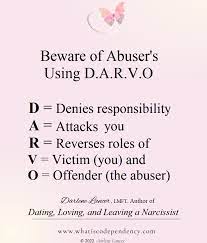Darvo

In the realm of psychology, patterns of behavior often manifest in complex and sometimes bewildering ways. One such phenomenon that has garnered attention in recent years is DARVO – an acronym that stands for Deny, Attack, and Reverse Victim and Offender. Originally coined by Dr. Jennifer Freyd, this concept provides insight into the tactics individuals may employ when faced with allegations of wrongdoing. Let’s delve into the depths of DARVO to understand its implications and significance in various contexts.
Table of Contents
ToggleUnderstanding DARVO
DARVO is a strategy often utilized by individuals who feel threatened or accused. The process unfolds in three distinct stages:
Deny
The first step involves outright denial of any wrongdoing. This can range from a simple refusal to acknowledge the allegations to actively presenting counterarguments or alternative explanations to discredit the accuser’s claims. Denial serves as a shield, protecting the individual’s reputation and deflecting accountability.
Attack
When denial alone proves insufficient, the next phase entails launching a counterattack against the accuser. This attack may take various forms, including character assassination, gaslighting, or shifting blame onto the individual who raised the allegations. By discrediting the accuser, the perpetrator aims to undermine their credibility and divert attention away from the original issue.
Reverse Victim and Offender
In the final stage of DARVO, the perpetrator adopts the role of the victim while portraying the actual victim as the offender. This strategic reversal aims to evoke sympathy and garner support from others. By painting themselves as the unjustly accused party, the perpetrator seeks to manipulate perceptions and rally allies to their side.
Application of DARVO
While DARVO can manifest in a myriad of interpersonal situations, it is particularly prevalent in contexts involving abuse, harassment, and power imbalances. Victims of abuse or misconduct may find themselves subjected to DARVO tactics when they attempt to speak out or seek justice. Perpetrators, fearing exposure and consequences, resort to DARVO as a means of self-preservation and maintaining control over the narrative.
Furthermore, DARVO is not limited to individual interactions but can also be observed on a larger scale within institutions, organizations, and even societal structures. Instances of institutional denial, victim-blaming, and the gaslighting of marginalized groups are all manifestations of DARVO dynamics at play.
Countering DARVO
Recognizing DARVO tactics is crucial in dismantling their effectiveness. By understanding the pattern of denial, attack, and victim reversal, individuals can better equip themselves to respond effectively. Key strategies for countering DARVO include:
Documentation
Keeping thorough records and evidence can substantiate claims and mitigate attempts at denial or distortion.
Validation
Providing validation and support to victims can help counteract the effects of gaslighting and victim-blaming.
Education
Raising awareness about DARVO and its implications can empower individuals to recognize and resist manipulative tactics.
Accountability
Holding perpetrators accountable for their actions is essential in disrupting cycles of abuse and enabling healing for victims.
Conclusion
DARVO represents a complex interplay of psychological mechanisms employed in response to allegations of misconduct. By shedding light on this phenomenon, we gain insight into the tactics used to evade accountability and perpetuate harm. By fostering awareness, validation, and accountability, we can work towards creating safer and more equitable environments where DARVO tactics hold no sway.





